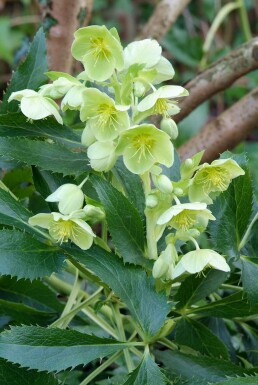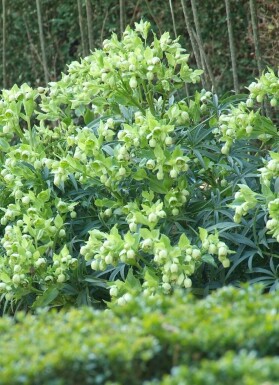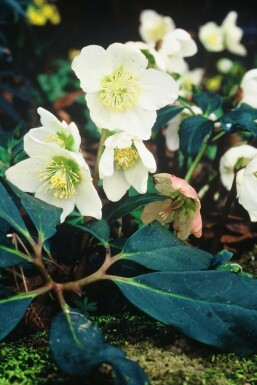

50cm



At Heijnen Plants, we take pride in presenting the Helleborus, a genus of perennial plants that adorn gardens with their evergreen foliage and elegant flowers. Revered for their early blooming period, hellebores offer a delightful array of green and white blossoms that emerge even in the coldest months, bringing life and color to subdued winter landscapes. These resilient plants are a splendid choice for gardeners seeking to create a serene and sophisticated green space that maintains its allure throughout the year.


50cm





40cm





30cm



The Helleborus, commonly known as hellebore, is a distinguished member of the Ranunculaceae family that adds a unique charm to winter and early spring landscapes. This genus is cherished for its resilience and the beauty it maintains during the colder months when most gardens lack color. Hellebores are a remarkable genus, not just for their vibrant, nodding flowers, but for their ability to thrive in the cooler and shadier corners of the garden, where other plants may falter.
In conclusion, Helleborus is a genus that offers enduring beauty with minimal upkeep, making it a splendid choice for gardeners looking to enhance the winter and early spring appeal of their outdoor spaces.
Embrace the enchanting beauty of hellebores, a distinguished addition to any garden with their robust demeanor and the remarkable ability to bloom in the quietude of winter. Their blossoms, ranging from elegant whites to deep purples, emerge as a herald of spring, while their lush foliage provides a verdant backdrop throughout the year. Cultivate a touch of serenity with these resilient perennials, a testament to the resilience and splendor of nature.
We would like to provide some tips on how to plant and care for a Helleborus. By following these tips, you can be sure to enjoy your Helleborus for a long time.
For optimal growth, Helleborus should be situated in an area with partial shade to full shade, making it an ideal candidate for underplanting beneath tree canopies or in the shadowed corners of a garden. While tolerant of a range of soil types, this evergreen perennial flourishes best in well-drained soil, rich in organic matter. It is important to avoid overly wet or waterlogged conditions to ensure the health of the plant. The sheltered conditions not only favor the longevity of its elegant blooms but also protect its lush, green foliage from the harsh midday sun.
When planting Helleborus, choose a location with partial shade to full shade to accommodate its preference for cooler environments. The soil should be well-drained to prevent waterlogging, which can be detrimental to the root system. Despite being adaptable to various soil types, incorporating organic matter at the time of planting will encourage a robust establishment. Space the plants adequately to ensure proper air circulation and to allow for their upright to bushy growth habit. Water the plants regularly to maintain an average moisture level, especially during dry spells, as they are not drought-resistant. Plant Helleborus in pots or directly into the border for a charming display from winter into spring.
To ensure the Helleborus thrives, a balanced approach to fertilization is key. Fertilize early in the spring as new growth appears, using a slow-release, balanced fertilizer to help support the lush foliage and vibrant blooms. A second application of fertilizer can be beneficial during the autumn to promote healthy roots and robust growth for the following season. Opt for a fertilizer formulated for evergreen plants to match the specific needs of this species.
It is important to water the plant after fertilizing to aid in the absorption of nutrients and to prevent root burn. Evenly distributing the fertilizer around the base of the plant, avoiding direct contact with the leaves and stems, will also help maintain optimal health and minimize the risk of damage to the plant.
Pruning of Helleborus should be approached with a gentle hand, primarily to remove old and damaged leaves which may detract from its aesthetic. The ideal time for this light pruning is late winter or early spring before the flush of new growth. Carefully cut back last year's foliage to make way for fresh, vibrant leaves and to showcase the plant's delightful blooms. Regular removal of withered or yellowed leaves throughout the year will keep the plant looking its best and help maintain its health.
To ensure the vitality of Helleborus, it is essential to maintain consistent moisture levels in the soil, particularly during its flowering period from January through April. The plant prefers well-drained soil and moderate watering, avoiding both waterlogged conditions and complete dryness. During the growing season, it's advisable to water deeply at longer intervals, promoting a robust root system. Throughout the winter months, reduce the frequency of watering as the plant's water requirements diminish. However, in the absence of sufficient natural precipitation, occasional watering may still be necessary to keep the soil from drying out completely.
One delightful aspect of the Helleborus is its capacity to bloom during the cooler months, often bringing color to the garden when most other plants are dormant. This species thrives in partial shade, making it an ideal choice for woodland gardens or shaded borders. Additionally, the Helleborus's leathery foliage remains attractive throughout the year, providing a persistent backdrop for seasonal blooms. It's a low-maintenance addition that offers enduring elegance to any outdoor space.
To maintain the health and vigor of Helleborus, division is a recommended practice. This should be carried out during the cooler months of spring or autumn. Carefully excavate the plant, ensuring minimal root disturbance, and gently separate it into smaller sections. Each division should have a good portion of the root system and several growth points. Replant these divisions promptly, placing them in well-draining soil within dappled shade locations. Through division, you not only promote robust growth but also rejuvenate older specimens, allowing the continued enjoyment of their unique, early-year blooms.
Embrace the enchanting beauty of Helleborus, a plant that graces winter gardens with its resplendent flowers. This species thrives in the cooler months, offering a splendid display when most plants are dormant. Its elegant blossoms and lush foliage make Helleborus a distinguished addition to any garden setting.
